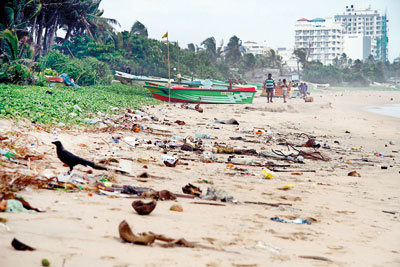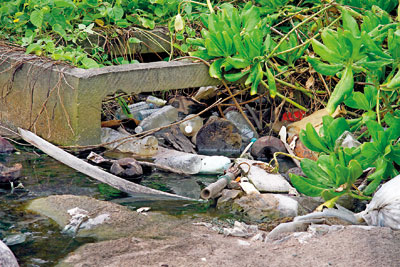News
Wading through rubbish on the beach – this must stop
As ugly and destructive garbage multiplies on Sri Lanka’s once-pristine beaches the authorities have vowed to improve rubbish collection and disposal systems while hope lies in innovative education schemes.

Dehiwala beach: A sea of plastic and other rubbish (above and below).Pix by Indika Handuwala
Coast Conservation Department Director-General Prabath Chandrakeerthi said his department carried out beach clean-ups with the aid of volunteers, local authorities and the Marine Environment Pollution Authority (MEPA) although they were not mandated to do so.
Mr. Chandrakeerthi said according to a UN report, 90 per cent of the world’s beaches were marked “unclean” and Sri Lanka had a high number of dirty beaches, with some of the garbage on the eastern coast coming from the Bay of Bengal.
The Commissioner of the Batticaloa Municipal Council, Nagarasa Manivannan, said his council planned to instal separate garbage bins along the beach for plastic and polythene litter in addition to the existing bins.
Mr. Manivannan said he hoped to stop people discarding plastic bottles, polythene bags and other wrappers on the beach. “We hope the installation of bins will minimise this behaviour. Also, we plan on carrying out awareness campaigns to educate the people on the damage this causes,” Mr. Manivannan said.
He said that apart from active dumping on the shore, waste also flowed into the sea from canals and lagoons.
“Many poultry farm owners dump their waste beside the Batticaloa lagoon. This happens mostly in the small hours of the night,” he said.
“We have units that monitor this, and if people are caught we take prompt legal action but mostly we find the rubbish dumped near the lagoon. We remove it because if we leave it there it will flow into the sea,” he said.
The Commissioner of the Dehiwela-Mount Lavinia Municipal Council, N. Muthugala, said his council had carried out beach clean-ups with the help of volunteers on three days recently.
“We have also signed a Memorandum of Understanding (MoU) with the NGO Sevanatha, which is funded by the United States Agency for International Development (USAID) for the precise purpose of preventing rubbish from getting onto the beaches,” Mr. Muthugala said.
He said the main causes for garbage collecting on the shores of Dehiwela and Mount Lavinia were because it was carried there through canals and because people who lived along the beach in shanties and others who frequented the beach dumped rubbish there.
“We need a permanent solution for the shanty dwellers who are some of the biggest polluters of Dehiwela beach,” he said. “If these people are relocated to better housing facilities away from the coast, I believe this problem will be greatly reduced.”
Sevanatha Executive Director H. Chularatne said his organisation planned to set up “waste traps” along the banks of canals to prevent people from dumping waste into the water and to educate dwellers near canals not dump their waste.
The Chairman of the Panadura Urban Council, Nandana Gunathilaka, said the council planned to purchase a new cleaning machine that would increase the efficiency of beach clean-ups but that it could not afford the machine this time.
Yasmin Perera, a resident of Dehiwela who lives near the beach, said it was tragic to see what was happening to the beaches.
“I blame organisations that produce, package, and still use plastic bags. There was a clean-up of Dehiwela beach but it went back to its disgusting state the very next day,” Ms. Perera said.
In the north, there was condemnation of the “irresponsible” behaviour of visitors to the popular beach at Karaingar.
“Tourists and locals throw bottles, cans and polythene bags on Casuarina Beach. This is a popular tourist beach in the north. We have placed garbage bins there but no-one pays any heed to them. We also carry out clean-ups, but with this irresponsible attitude it is very difficult,” Karainagar Pradheshiya Sabha Chairman Vijayatharma Ketheeswarathas said.
MEPA General Manager Dr. Terney Pradeep Kumara explained the effects of polluting the coast and the ocean.
“When liquid waste such as agro-chemicals and certain pharmaceuticals go into the sea, it affects the breeding of marine life. Mutations occur. Micro-communities are killed. When the food of one species is contaminated and they feed on it, the food chain is affected. Floating solid waste on the ocean top blocks light and marine life suffer. These chemicals cause fish to be smothered to death,” Dr. Kumara said.
Additionally, he said, the waste on the shore provided breeding grounds for dengue mosquitoes, and the visual pollution affected the tourist trade.
Dr. Kumara said MEPA had begun various projects to educate the public.
“In one of our projects we carried out a full clean-up of the beach and then handed over a 1km-stretch of the beach to one family to maintain. We hope to expand this to 60 families for the first phase,” he said, adding that MEPA was seeking funding from the private sector for this.
“This is an issue that cannot be dealt with only regulatory measures. It requires a change in our culture,” he emphasised.

